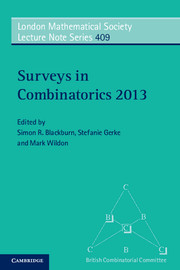Refine search
Actions for selected content:
48285 results in Computer Science
A Collaborative Approach to Teaching Sound Sculpting, Embodied Listening and the Materiality of Sound
-
- Journal:
- Organised Sound / Volume 18 / Issue 2 / August 2013
- Published online by Cambridge University Press:
- 11 July 2013, pp. 207-217
- Print publication:
- August 2013
-
- Article
- Export citation
The Maximal–Minimal Model: A framework for evaluating and comparing experience of voice in electroacoustic music
-
- Journal:
- Organised Sound / Volume 18 / Issue 2 / August 2013
- Published online by Cambridge University Press:
- 11 July 2013, pp. 218-228
- Print publication:
- August 2013
-
- Article
- Export citation
Forbidden Subgraphs Generating Almost the Same Sets
-
- Journal:
- Combinatorics, Probability and Computing / Volume 22 / Issue 5 / September 2013
- Published online by Cambridge University Press:
- 11 July 2013, pp. 733-748
-
- Article
- Export citation
OSO volume 18 issue 2 Cover and Front matter
-
- Journal:
- Organised Sound / Volume 18 / Issue 2 / August 2013
- Published online by Cambridge University Press:
- 11 July 2013, pp. f1-f2
- Print publication:
- August 2013
-
- Article
-
- You have access
- Export citation
The Appreciation of Electroacoustic Music: The prototype of the pedagogical ElectroAcoustic Resource Site
-
- Journal:
- Organised Sound / Volume 18 / Issue 2 / August 2013
- Published online by Cambridge University Press:
- 11 July 2013, pp. 124-133
- Print publication:
- August 2013
-
- Article
- Export citation
Rainbow Perfect Matchings in Complete Bipartite Graphs: Existence and Counting
-
- Journal:
- Combinatorics, Probability and Computing / Volume 22 / Issue 5 / September 2013
- Published online by Cambridge University Press:
- 09 July 2013, pp. 783-799
-
- Article
- Export citation
Applications and extensions of Alloy: past, present and future
-
- Journal:
- Mathematical Structures in Computer Science / Volume 23 / Issue 4 / August 2013
- Published online by Cambridge University Press:
- 08 July 2013, pp. 915-933
-
- Article
- Export citation
Can we build it: formal synthesis of control strategies for cooperative driver assistance systems†
-
- Journal:
- Mathematical Structures in Computer Science / Volume 23 / Issue 4 / August 2013
- Published online by Cambridge University Press:
- 08 July 2013, pp. 676-725
-
- Article
- Export citation
Preface to special issue: lightweight and practical formal methods in the design and analysis of safety-critical systems
-
- Journal:
- Mathematical Structures in Computer Science / Volume 23 / Issue 4 / August 2013
- Published online by Cambridge University Press:
- 08 July 2013, p. 675
-
- Article
-
- You have access
- Export citation
STRUCTURAL EQUATIONS AND BEYOND
-
- Journal:
- The Review of Symbolic Logic / Volume 6 / Issue 4 / December 2013
- Published online by Cambridge University Press:
- 08 July 2013, pp. 709-732
- Print publication:
- December 2013
-
- Article
- Export citation
A modular formal semantics for Ptolemy†
-
- Journal:
- Mathematical Structures in Computer Science / Volume 23 / Issue 4 / August 2013
- Published online by Cambridge University Press:
- 08 July 2013, pp. 834-881
-
- Article
- Export citation
A formal approach to collaborative modelling and co-simulation for embedded systems†
-
- Journal:
- Mathematical Structures in Computer Science / Volume 23 / Issue 4 / August 2013
- Published online by Cambridge University Press:
- 08 July 2013, pp. 726-750
-
- Article
- Export citation
Model checking for performability
-
- Journal:
- Mathematical Structures in Computer Science / Volume 23 / Issue 4 / August 2013
- Published online by Cambridge University Press:
- 08 July 2013, pp. 751-795
-
- Article
- Export citation
Postlude: seamless composition and integration – a perspective on formal methods research
-
- Journal:
- Mathematical Structures in Computer Science / Volume 23 / Issue 4 / August 2013
- Published online by Cambridge University Press:
- 08 July 2013, pp. 934-943
-
- Article
- Export citation
Rigorous implementation of real-time systems – from theory to application
-
- Journal:
- Mathematical Structures in Computer Science / Volume 23 / Issue 4 / August 2013
- Published online by Cambridge University Press:
- 08 July 2013, pp. 882-914
-
- Article
- Export citation
MSC volume 23 issue 4 Cover and Back matter
-
- Journal:
- Mathematical Structures in Computer Science / Volume 23 / Issue 4 / August 2013
- Published online by Cambridge University Press:
- 08 July 2013, pp. b1-b5
-
- Article
-
- You have access
- Export citation
Employing UML and OCL for designing and analysing role-based access control
-
- Journal:
- Mathematical Structures in Computer Science / Volume 23 / Issue 4 / August 2013
- Published online by Cambridge University Press:
- 08 July 2013, pp. 796-833
-
- Article
- Export citation
Excluded Forest Minors and the Erdős–Pósa Property
-
- Journal:
- Combinatorics, Probability and Computing / Volume 22 / Issue 5 / September 2013
- Published online by Cambridge University Press:
- 08 July 2013, pp. 700-721
-
- Article
- Export citation
MSC volume 23 issue 4 Cover and Front matter
-
- Journal:
- Mathematical Structures in Computer Science / Volume 23 / Issue 4 / August 2013
- Published online by Cambridge University Press:
- 08 July 2013, pp. f1-f2
-
- Article
-
- You have access
- Export citation

Surveys in Combinatorics 2013
-
- Published online:
- 05 July 2013
- Print publication:
- 27 June 2013











